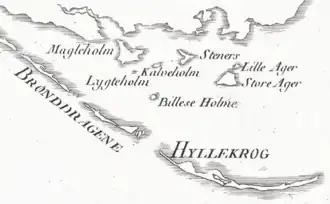Battle of Fehmarn (1659)
| Battle of Fehmarn | |||||||||
|---|---|---|---|---|---|---|---|---|---|
| Part of the Dano-Swedish War (1658–1660) | |||||||||
 Map of the Rødsand shoal | |||||||||
| |||||||||
| Belligerents | |||||||||
|
|
| ||||||||
| Commanders and leaders | |||||||||
|
|
| ||||||||
| Units involved | |||||||||
| Unknown |
| ||||||||
| Strength | |||||||||
|
20–24 warships 2 fireships Several galleons |
22–26 warships Several galleons and transport ships | ||||||||
| Casualties and losses | |||||||||
|
12 officers and men killed 26 wounded | At least 1 ship damaged | ||||||||
54°34′11″N 11°25′49″E / 54.569693°N 11.430173°E
The battle of Fehmarn (Swedish: Sjöslaget vid Femern; Danish: Slaget ved Rødsand; Dutch: Zeeslag bij Fehmarn), also known as the battle of Rödsund,[1] occurred on 30 April, 1659 during the Dano-Swedish War of 1658–1660. It was fought in the Fehmarn Belt between a Swedish fleet under Klas Hansson Bjelkenstjerna and a Dano-Dutch fleet under Jacob van Wassenaer Obdam. The battle ended inconclusively.
Background
Following the Battle of the Sound, Swedish forces had been driven out from Zealand, but continued to occupy the Island of Funen. Dano-Dutch forces under Jacob van Wassenaer Obdam, which were defending the Øresund strait, sailed downwind to meet the Swedish fleet in the Fehmarn Belt.[2]
On 30 April, 1659, a Swedish fleet under the command of Klas Hansson Bjelkenstjerna encountered its Dutch counterpart under Jacob van Wassenaer Obdam and the Danish one under Henrik Bielke between Fehrmarn and Lolland.[3]
The Swedish fleet consisted of 20[3]–24[2] warships, two fire ships, and some galleons, while the allied fleet consisted of three Danish warships and 19[3]–23[2] Dutch warships, along with some galleons and transport ships. Bjelkenstjerna decided to attack the allied fleet despite being outnumbered and a weak crew due to starvation.[4]
Battle
Both sides maneuvered to get into their positions, and when they passed each other, they opened fire. The wind became so strong that neither side was able to open their gun ports. However, sufficient fire was able to be maintained from other decks. During the fighting, a six pound cannonball hit Bjelkenstjerna in his hip, forcing him to withdraw to the stern, leading to Carl Gustaf Wrangel taking over command.[5][6][7]
The two fleets continued passing by each other at close range, exchanging heavy cannon fire. The Swedes were able to hit several allied ships, particularly the Danish Trefoldigheden, with several of its sails being shot down, and making maneuvering it difficult. Opdam arrived with reinforcements, successfully preventing the damaged Trefoldigheden from further attacks.[5]
The fleets turned once more, and the Swedes came into the wind, however, the harsh weather made it impossible to keep the fleet together for close combat, leading to Wrangel having to stay as still as possible and wait for the allied ships. The evening continued with continuous artillery fire, but when it became dark, Wrangel decided to withdraw in order to seek a harbour to assess the damage done to his ships. Opdam made the same decision, and the fleets separated.[5] Wrangel's forces withdrew towards the northeast, and a small force remained near Copenhagen, however the majority of the fleet returned to Landskorna.[2]
Aftermath
The Swedish losses sustained during the battle were some 12 officers and men killed, with 26 wounded, and the size of the allied fleet remains unknown.[5] According to some sources, the battle ended in a draw[5][6][8][1] while others claim it was tactically inconclusive but with a strategic outcome favoring the allies.[9][10]
References
- ^ a b Glete 2010, p. 181.
- ^ a b c d Harding 2002, p. 77.
- ^ a b c Isacson 2015, p. 238.
- ^ Isacson 2015, p. 238–239.
- ^ a b c d e Isacson 2015, p. 239.
- ^ a b Jacobson, G. "Klas Hansson Bielkenstierna". National Archives of Sweden (in Swedish). Retrieved 2024-12-01.
- ^ Bäckström 1884, p. 131.
- ^ Essen 2023, p. 328.
- ^ Albrechtsen 2006, p. 198.
- ^ Nordentoft 1937, p. 63.
Works cited
- Isacson, Claes-Göran (2015). Karl X Gustavs krig: Fälttågen i Polen, Tyskland, Baltikum, Danmark och Sverige 1655-1660 [Wars of Charles X Gustav: The campaigns in Poland, Germany, the Baltics, Denmark and Sweden 1655-1660] (in Swedish). Historiska Media. ISBN 9789175450117.
- Bäckström, Per Olof (1884). Svenska flottans historia [History of the Swedish fleet] (in Swedish). Stockholm: Norstedts förlag.
- Harding, Richard (2002). Seapower and Naval Warfare, 1650–1830. Taylor & Francis. ISBN 9781135364854.
- Essen, Michael (27 January 2023). Charles X's Wars: Volume 3 - The Danish Wars, 1657-1660. Helion & Company. ISBN 978-1915113603.
- Glete, Jan (2010). Swedish Naval Administration, 1521-1721. Brill. ISBN 9789047441519.
- Albrechtsen, Svend (2006). Grunde, rev og flak (in Danish). Iver C. Weilbach & Company. ISBN 978-87-7790-165-2.
- Nordentoft, Johan (1937). Nakskov og Svenskerne 1658 og 1659 III (in Danish). C. A. REITZELS FORLAG.